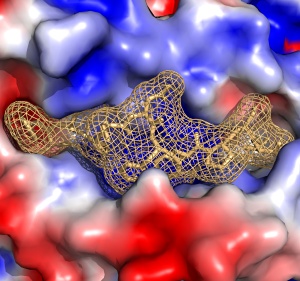
An HBV fragment (brown) binding to the HLA protein
Hepatitis B virus (HBV) is endemic throughout much of Asia, including Singapore, and can lead to liver damage and liver cancer in chronically infected individuals. Ee Chee Ren at the A*STAR Singapore Immunology Network and co-workers have now demonstrated how different human antigen-presenting proteins capture fragments of HBV proteins (see image) to initiate immune responses to the virus.
Humans possess unique antigen-presenting proteins called human leukocyte antigens (HLAs), which are responsible for inducing immune reactions to pathogens, including HBV. One particular HLA type, called A*02:01, is the main variant found in Caucasians, while Asians tend to possess a more diverse composition comprising A*02:07, A*02:06 and A*02:03. These HLA genetic variants each have slight changes in their amino acid sequences, and these differences may affect how they bind to and initiate immune reactions against HBV or other pathogens. A*02:01 and A*02:07 have only one difference in their amino acid sequence, while A*02:03, an HLA that can be found in Asians, has three amino acid differences from A*02:01.
Ren and his co-workers used a structural biology technique called X-ray crystallography to determine how the different HLAs interacted with a portion of HBV. They found that some HLA alleles, including A*02:01 and A*02:07, seem to bind to HBV quite tightly, while A*02:03 binds more loosely. The researchers attributed this change in binding of A*02:03 to two of its amino acids, which are not present in the other HLAs. These amino acids reside in the antigen-binding pocket of A*02:03 and take up more space than in the other HLAs. This therefore makes it more difficult for HBV to fit tightly into the antigen-binding pocket of A*02:03. Ren and his co-workers then went on to suggest how to modify the HBV antigen so that it could bind more effectively to A*02:03, and therefore initiate the most effective immune responses to the virus in individuals with this HLA type.
The findings indicate that a ‘one-size-fits-all’ vaccine strategy for HBV is unlikely to be effective in inducing efficient immune reactions in people with different HLAs. Instead, HBV antigens used for HBV vaccination should ideally be matched to different HLA types for more effective prevention and treatment of HBV.
“The results from this study define general principles of antigen binding and can be applied to improve vaccine development for many diseases,” explains Ren. “Future vaccines would most likely have to be comprised of multiple antigens that can elicit a strong immune response in any population.”
The A*STAR-affiliated researchers contributing to this research are from the Singapore Immunology Network.



